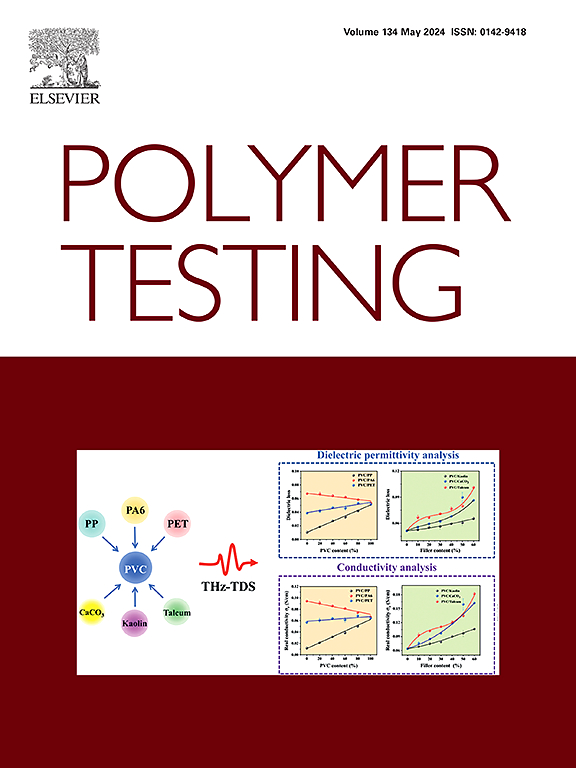Study of mechanical and physical properties of pineapple leaf fiber and coffee husk filler reinforced polymer composite using response surface method
IF 6
2区 材料科学
Q1 MATERIALS SCIENCE, CHARACTERIZATION & TESTING
引用次数: 0
Abstract
In the search for structural materials that are strong, lightweight, and cheap, pineapple leaf, which is rich in cellulose and relatively inexpensive, seems to have good potential reinforcement in yarn production. Pineapple leaf fibers (PALF) and coffee husk filler (CHF) can be new sources of raw materials for industries and can be potential for polymer reinforcement. This study fabricates composite samples using the hand layup method, and the Response Surface Methodology is used to optimize the experimental design. An analysis of variance determines the significance of variables and the interaction between them and responses. To assess mechanical characteristics (such as tensile, compression, flexural, and impact strength), and the physical properties like, thermogravimetric, water absorption, characterization, regression models are developed and statistically validated. The quadratic model is found to be the best fit for the tensile strength, flexural strength, impact strength, and water absorption models, while the two-factor interaction model is determined to be the best fit for the compression strength. The primary significant output parameter contributions in all responses are 28.497 % of PALF for tensile strength, 65.41 % of PALF for compression strength, 29.755 % of CHF for flexural strength, 84.454 % of PALF for impact strength, and 56.92 % of PALF for water absorption.
用响应面法研究菠萝叶纤维与咖啡壳填料增强聚合物复合材料的力学和物理性能
在寻找坚固、轻便和廉价的结构材料的过程中,菠萝叶富含纤维素,相对便宜,似乎在纱线生产中具有良好的增强潜力。菠萝叶纤维(PALF)和咖啡壳填料(CHF)可以成为工业原料的新来源,并有可能成为聚合物增强材料。本研究采用手铺法制备复合材料样品,并利用响应面法优化实验设计。方差分析决定了变量的重要性以及它们与响应之间的相互作用。为了评估机械特性(如拉伸、压缩、弯曲和冲击强度)和物理特性(如热重、吸水、表征),开发了回归模型并进行了统计验证。在抗拉强度、抗折强度、冲击强度和吸水率模型中,二次元模型最适合;在抗压强度模型中,双因素相互作用模型最适合。在所有响应中,主要的显著输出参数贡献为抗拉强度占PALF的28.497%,抗压强度占PALF的65.41%,弯曲强度占PALF的29.755 %,冲击强度占PALF的84.454%,吸水率占PALF的56.92%。
本文章由计算机程序翻译,如有差异,请以英文原文为准。
求助全文
约1分钟内获得全文
求助全文
来源期刊

Polymer Testing
工程技术-材料科学:表征与测试
CiteScore
10.70
自引率
5.90%
发文量
328
审稿时长
44 days
期刊介绍:
Polymer Testing focuses on the testing, analysis and characterization of polymer materials, including both synthetic and natural or biobased polymers. Novel testing methods and the testing of novel polymeric materials in bulk, solution and dispersion is covered. In addition, we welcome the submission of the testing of polymeric materials for a wide range of applications and industrial products as well as nanoscale characterization.
The scope includes but is not limited to the following main topics:
Novel testing methods and Chemical analysis
• mechanical, thermal, electrical, chemical, imaging, spectroscopy, scattering and rheology
Physical properties and behaviour of novel polymer systems
• nanoscale properties, morphology, transport properties
Degradation and recycling of polymeric materials when combined with novel testing or characterization methods
• degradation, biodegradation, ageing and fire retardancy
Modelling and Simulation work will be only considered when it is linked to new or previously published experimental results.
 求助内容:
求助内容: 应助结果提醒方式:
应助结果提醒方式:


